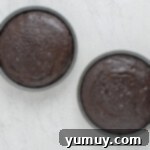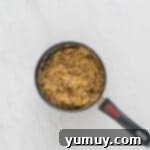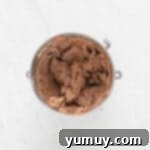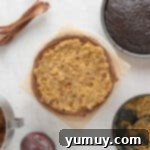Ultimate Easy German Chocolate Cake: A Decadent Delight Made Simple
There are few desserts as universally adored as a slice of moist, rich German chocolate cake. Its signature combination of tender chocolate layers, sweet and gooey coconut-pecan filling, and luscious chocolate buttercream is simply irresistible. This recipe captures all that classic decadence, but with a clever twist: it starts with a boxed cake mix. This smart shortcut allows you to focus your culinary creativity (and energy!) on crafting the show-stopping, deeply flavorful homemade coconut-pecan icing and velvety chocolate buttercream that truly elevate this cake to an extraordinary level. The result is a dessert that tastes entirely from scratch, yet is surprisingly approachable for any home baker.
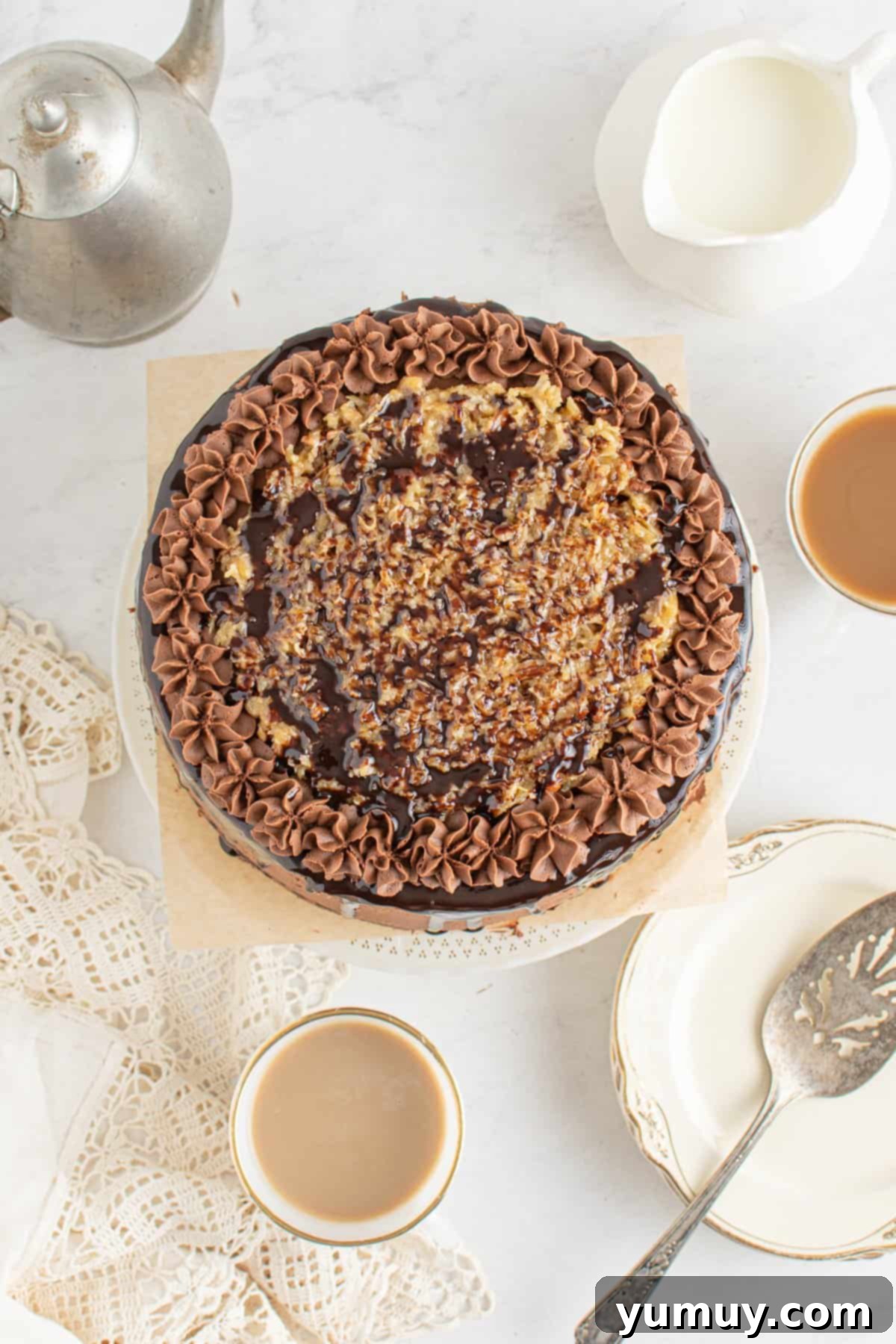
Unraveling the Mystery: The German Chocolate Cake’s True Origin
Despite its name, German chocolate cake doesn’t actually hail from Germany. This beloved American classic traces its roots back to 1852, when an English-American chocolate maker named Samuel German developed a specific type of dark baking chocolate for the Baker’s Chocolate Company. This unique chocolate, known for its sweet and mild flavor profile, became famous as “Baker’s German’s Sweet Chocolate.” Decades later, in 1957, a recipe for “German’s Chocolate Cake” was published in a Dallas newspaper, crediting Mrs. George Clay for its creation. The recipe quickly gained national popularity, and over time, the apostrophe “s” was dropped, leading to the familiar “German Chocolate Cake” we know today. Our recipe honors this tradition by delivering an authentic flavor experience, simplifying the process without compromising on taste.
The Genius of a Boxed Cake Mix Base
Using a boxed chocolate cake mix is the secret weapon in this recipe, transforming a potentially daunting baking project into an enjoyable and achievable one. While some purists might scoff, a high-quality cake mix provides a consistent, tender crumb and rich chocolate flavor with minimal effort. This frees you up to dedicate your time to the elements that truly define German chocolate cake: its iconic homemade fillings and frostings. The beauty of this approach is that you get all the impressive layers and intricate flavors of a traditional German chocolate cake without spending hours on complex cake batter from scratch. It’s about working smarter, not harder, to achieve bakery-quality results in your own kitchen.
The Star of the Show: Homemade Coconut-Pecan Icing
The coconut-pecan icing is undeniably the heart and soul of any German chocolate cake. This recipe’s homemade version is thick, glossy, and bursting with flavor, making it the true highlight. We combine rich egg yolks, fragrant brown sugar, granulated sugar for texture, creamy evaporated milk, and a generous amount of unsalted butter. These ingredients are slowly simmered together, requiring constant whisking to achieve that perfect, luscious consistency – thick enough to cling to the cake layers without being overly dense. The final additions of sweetened shredded coconut and finely chopped pecans introduce an incredible textural contrast and a delightful nutty sweetness that balances the rich chocolate cake. This filling is not just a component; it’s a sensory experience, delivering warmth, depth, and unmistakable classic flavor in every bite.
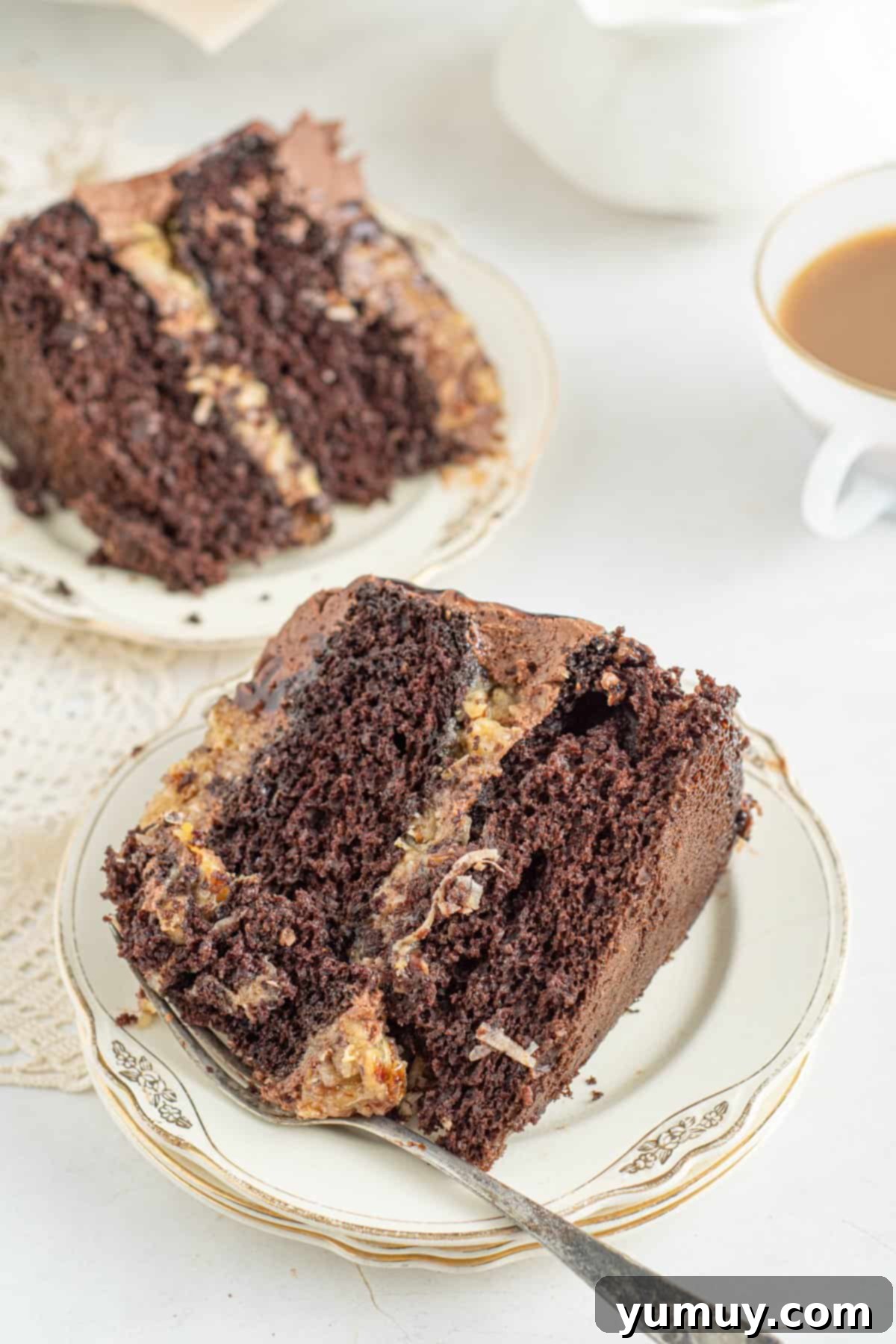
Enhancing Flavor: Toasting Pecans is a Must
For a German chocolate cake that truly stands out, don’t skip the simple step of toasting your pecans. This quick process, taking only a few minutes in a preheated oven, makes a dramatic difference in the overall flavor profile of your coconut-pecan icing. Raw pecans can sometimes taste a bit dull or even slightly bitter, but toasting them unlocks their natural oils, intensifying their nutty aroma and creating a deeply caramelized, more balanced flavor. The heat brings out a warmth and complexity that raw nuts simply cannot match, adding an extra layer of gourmet sophistication to your homemade icing. This small effort yields a significant return, elevating the entire cake to the next level of deliciousness.
The Perfect Companion: Velvety Chocolate Buttercream
While the coconut-pecan icing gets much of the attention, a smooth, rich chocolate buttercream is essential for tying all the magnificent layers of this cake together. Our recipe features a simple yet indulgent buttercream made with powdered sugar, unsalted butter at room temperature, unsweetened cocoa powder, and pure vanilla extract. Whipped to a light and fluffy consistency, this buttercream provides a creamy counterpoint to the dense cake and the chewy filling. It acts as a delicious adhesive, sealing in the coconut-pecan goodness and providing a beautiful, professional finish to the cake’s exterior. The subtle bitterness of the cocoa powder in the buttercream perfectly complements the sweetness of the filling, ensuring every forkful is a harmonious blend of textures and flavors. It’s the elegant capstone to a truly spectacular dessert.
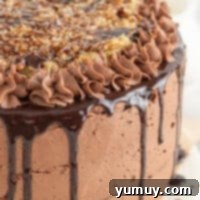
German Chocolate Cake Recipe
Rate
Save
Ingredients
For the Cake
- 15.25 ounces chocolate cake mix (1 box)
- 1¼ cups water
- ½ cup unsalted butter melted (1 stick)
- 3 large eggs
For the Icing
- 4 egg yolks whisked*
- ½ cup brown sugar
- ½ cup granulated sugar
- 8 ounces evaporated milk (⅔ can)
- ½ cup unsalted butter (1 stick)
- 1 teaspoon pure vanilla extract
- 1⅔ cups sweetened shredded coconut
- 1 cup chopped pecans
For the Buttercream
- 5 cups powdered sugar
- 1½ cups unsalted butter room temperature (3 sticks)
- ⅔ cup unsweetened cocoa powder
- 1 teaspoon pure vanilla extract
- Milk optional, for consistency
- Chocolate syrup optional, for drizzling
Equipment
- Kitchen Scale (optional)
- 2 9-inch Round Cake Pan(s)
- Hand Mixer or Stand Mixer
- Piping Tip Set
Instructions
- Preheat oven to 350°F (175°C). Line 2 (9-inch) round cake pans with parchment paper and lightly spray with nonstick baking spray. This ensures your cake layers release perfectly.
- In a medium bowl, combine the chocolate cake mix, water, melted unsalted butter, and large eggs. Mix until just combined, being careful not to overmix, which can lead to a tough cake.

- Divide the prepared batter evenly between the two cake pans (approximately 483 grams or 17 ounces per pan, if using a kitchen scale for precision). Place into the preheated oven and bake for 25 minutes, or until a wooden toothpick inserted into the center of the cakes comes out clean or with only moist crumbs attached. Once baked, remove the pans from the oven and transfer the cake layers to a wire cooling rack to cool completely. This step is crucial before frosting, otherwise, your icing will melt.

- While the cake layers are cooling, prepare the rich coconut-pecan icing. In a large saucepan, combine the whisked egg yolks, brown sugar, granulated sugar, evaporated milk, unsalted butter, and pure vanilla extract. Place the saucepan over medium heat and bring the mixture to a gentle simmer. Continue to simmer for 6-7 minutes, whisking constantly to prevent the mixture from scorching or curdling. The icing should thicken and become beautifully glossy. Remove from heat and carefully fold in the sweetened shredded coconut and chopped pecans until well distributed. Set this luscious icing aside to cool slightly.

- Next, make the velvety chocolate buttercream. In the bowl of a stand mixer fitted with the paddle attachment (or using a hand mixer), combine the powdered sugar, room-temperature unsalted butter, unsweetened cocoa powder, and pure vanilla extract. Beat on high speed for 5-6 minutes, or until the mixture transforms into a smooth, light, and fluffy frosting. If you find your buttercream is too dry or thick for your liking, gradually add milk, one tablespoon at a time, until it reaches your desired consistency. Transfer about ½ cup of this fluffy frosting to a piping bag fitted with a star tip for decoration; set the remaining buttercream aside for coating the cake.

- To begin assembling your magnificent cake, carefully place one of the completely cooled cake layers onto your chosen serving plate or cake stand.

- Using an offset spatula or a rubber spatula, spread a thin layer (about ¼ cup) of the chocolate buttercream evenly over the top of the first cake layer. This acts as a delicious base. Then, using your piping bag, pipe a ring of buttercream around the outer edge of this cake layer. This “dam” will create a barrier, preventing your precious coconut-pecan icing from spilling over the sides. Carefully spoon half of the coconut-pecan icing into the center of the buttercream ring, spreading it gently to fill the space.

- Gently place the second cooled cake layer on top of the filling, carefully aligning the edges to ensure a neat, even cake. Ensure the cake does not hang over on any side. Now, spread the remaining chocolate buttercream evenly over the entire top surface and the sides of the cake, creating a smooth, inviting finish. For an extra touch of elegance and indulgence, drizzle chocolate syrup artfully over the edges of the cake, creating attractive “drips” down the sides, if desired. Using the piping bag, pipe a decorative ring of buttercream swirls around the top edge of the cake. Carefully spoon the remaining coconut-pecan icing into the middle of these swirls and gently smooth it out. For a final flourish, drizzle additional chocolate syrup in a crosshatch pattern over the top of the coconut-pecan icing. Your masterpiece is complete! Slice and serve this magnificent German chocolate cake to rave reviews.

Notes and Expert Tips
Tips for Success:
- For the best texture in your cake batter and buttercream, always use room temperature eggs and butter. This allows ingredients to emulsify better, resulting in a smoother batter and a more tender cake crumb.
- Avoid overmixing the cake batter. Mix just until the ingredients are combined. Overmixing develops too much gluten, which can make your cake tough and dry.
- It is absolutely essential that your cake layers are completely cooled before you begin frosting. If the cake is even slightly warm, the buttercream and especially the coconut-pecan icing will melt and slide right off, creating a messy situation.
- Toasting pecans truly deepens their flavor. Spread them on a baking sheet and toast at 350°F (175°C) for 5-7 minutes, keeping a close eye on them to prevent burning. Let them cool before chopping and adding to the icing.
- When simmering the coconut-pecan icing, whisk constantly. This continuous stirring prevents the egg yolks from curdling and the mixture from scorching on the bottom of the pan, ensuring a perfectly smooth and glossy filling.
- The buttercream “dam” around the edges of your cake layers is critical. It creates a sturdy barrier that holds the gooey coconut-pecan icing securely in place, preventing it from oozing out the sides when the top layer is added.
- For clean, professional-looking slices, chill the assembled cake in the refrigerator for at least 30 minutes (or even an hour) before cutting and serving. This allows the frosting and filling to set, making for much neater portions.
- Nutritional information provided does not include optional ingredients such as extra milk for consistency or chocolate syrup for drizzling.
Make-Ahead Instructions: You can prepare the cake layers, the coconut-pecan icing, and the chocolate buttercream up to 1 day in advance. Store the cooled cake layers wrapped tightly at room temperature, and the icing and buttercream in airtight containers in the refrigerator. On the day of serving, bring the icing and buttercream to room temperature (re-whip the buttercream if needed), and then assemble your cake fresh.
Storage Recommendations: Store any leftover German chocolate cake in an airtight container to maintain its freshness. It will keep beautifully at room temperature for up to 5 days, in the refrigerator for up to 1 week, or in the freezer for up to 3 months. If freezing, wrap individual slices or the whole cake tightly in plastic wrap and then aluminum foil. Let frozen cake thaw overnight in the refrigerator before bringing to room temperature and enjoying.
Calories from Fat 549
@easydessertrecipes
for a chance to be featured.
Frequently Asked Questions About German Chocolate Cake
Q: Can I make this cake entirely from scratch?
A: Absolutely! While this recipe uses a boxed mix for convenience, you can certainly substitute your favorite homemade chocolate cake recipe. Just ensure it yields two 9-inch round layers of a similar density for the best results with the rich fillings.
Q: What is evaporated milk, and can I substitute it?
A: Evaporated milk is a shelf-stable canned milk product where about 60% of the water has been removed. It’s thicker and creamier than regular milk, giving the coconut-pecan icing its signature rich texture. While not ideal, you could try substituting with heavy cream or half-and-half, but the flavor and consistency of the icing might vary slightly. Avoid using condensed milk, as it is heavily sweetened and will make the icing too sugary.
Q: How can I prevent my buttercream from being too sweet or too dense?
A: To avoid overly sweet buttercream, ensure your butter is truly at room temperature. This allows it to whip up light and airy, incorporating more air and reducing density. Using a good quality unsweetened cocoa powder also helps balance the sweetness of the powdered sugar. If it feels too dense, adding a tablespoon of milk at a time will loosen it up to the perfect consistency.
Q: What’s the best way to chop pecans for the icing?
A: For the coconut-pecan icing, you want the pecans to be finely chopped but not pulverized into a powder. This ensures you get small pieces for texture without having large, chunky nuts. You can chop them by hand with a knife, pulse them briefly in a food processor, or even place them in a bag and crush them with a rolling pin.
More Chocolate Cake Recipes to Try!
Chocolate Cake Pops
Chocolate Sour Cream Pound Cake
Chocolate Mug Cake
Chocolate Mousse Cake
Browse All Cakes
This German chocolate cake recipe, while boasting a few more ingredients than some of our simplest desserts, is truly worth every step. The combination of a moist cake base with that unparalleled homemade coconut-pecan icing and fluffy chocolate buttercream creates a dessert experience that’s both deeply satisfying and incredibly impressive. It’s a labor of love that tastes like a professional bakery creation, perfect for special occasions or whenever you crave a truly remarkable chocolate fix. Don’t let the ingredient list intimidate you; the process is straightforward, and the delicious reward is well worth the effort. Happy baking!


